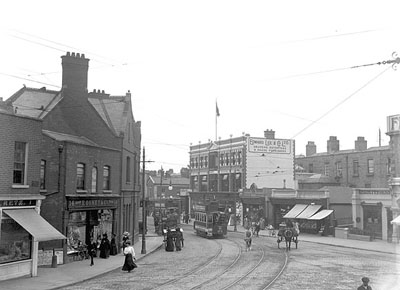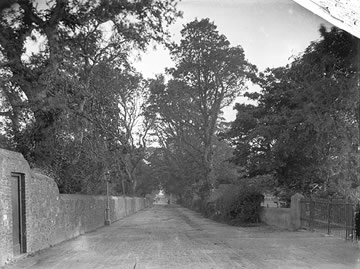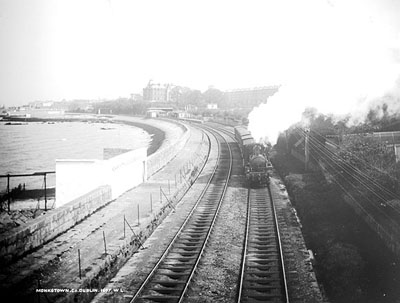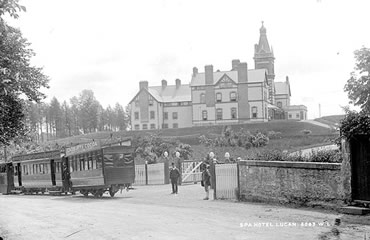The Suburbs
View the photo galleryThe growth of residential areas away from the central shopping, commercial and industrial core of a city was a common phenomenon in the nineteenth and early twentieth century across Europe. Dublin was no exception. The city had been surrounded by outlying villages - Kingstown, Donnybrook, Chapelizod, Malahide and many more - for several centuries. By 1911 significant change in the pattern of Dublin life had drawn such villages more closely to the life of the city.
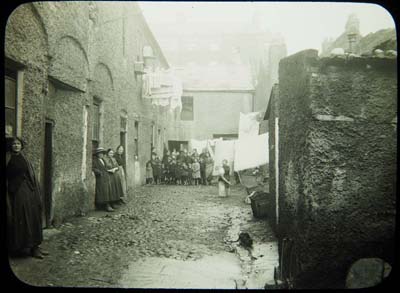
The flight of wealth to the suburbs often meant an escape from inner city squalor. This photograph of Henrietta Place was taken in 1913.
(RSAI, Darkest Dublin Collection)
In part the move to the suburbs was a flight of wealth. At the end of the eighteenth century, the spacious streets at the centre of the city were dominated by a moneyed lifestyle at odds with the squalor of the poorer population. In the south of the city, from St Stephen’s Green through Merrion Square and Fitzwilliam Square, great Georgian houses were homes for many of the nobility, the gentry and the higher professions. On the north side, Mountjoy Square and Rutland Square, as well as fashionable streets such as Henrietta Street and North Great Georges Street, were home to many leading members of the legal, ecclesiastical and business communities. By 1911 much of this had changed.
The nineteenth century saw a steady move to suburbs such as Rathmines, Monkstown and Blackrock by many wealthy Dubliners. Not all who could afford to left for the suburbs: for example, Fitzwilliam Square and Merrion Square on the southside remained the preserve of the wealthy. This was a world of doctors, like Ormsby of Merrion Sq. West, dentists, like Story of Upper Fitzwilliam St. , top civil servants, like Thompson of Fitzwilliam Sq., North, lawyers like Walker of Fitzwilliam Sq., West, and army officers like Cary-Bernard of Upper Fitzwilliam St. . The old fashionable districts of the north side, however, were almost entirely abandoned. Among the starkest examples were the great buildings of Henrietta Street, which were now tenements, and this story was retold in the tenements of Mountjoy Square and Parnell Square.
Inevitably, the suburbs were not uniformly affluent or even prosperous. Nonetheless, it was clear that the relocation was initiated by the professional classes, like dentist Reynolds at Upr. Georges’ St, Kingstown, who sought residence at a distance from the polluted, overcrowded city centre. And it was equally clear that the loss of many of its more affluent inhabitants had a detrimental affect on the development of life in the inner city. In this respect, Ireland reflected trends in many other European cities.
In part this relocation was driven by the growth of the middle classes, like civil engineer Crawforth-Smith of Ailesbury Park, who sought houses which reflected their new-found status, houses which could not in any case be provided within the confines of the city limits. Development of such suburbs was driven by businessmen and property developers, as in the case of Rathmines, or independent landowners, as in the case of Pembroke, which was the project of the Earl of Pembroke.
And it was relentless development. From the 1860s the inner suburbs of Rathmines and Pembroke grew year after year. By 1911 Rathmines and Pembroke accounted for up to half of the suburban population of Dublin, with Rathmines alone being home to 38,000 people, many of whom were clerical workers (see Stephenson of Dunville Ave).
Other suburbs were also strongly inhabited by various trades or professions. Kilmainham was filled with workers from the various railway companies who had engineering and other plants in the area, while there was also a formidable military presence, and Clontarf was home to clerks, like Verdon and salesmen, like Bradbury, both of Haddon Rd. Drumcondra had a lot of civil servants and a significant presence of priests (see return for Archbishop Walsh of Drumcondra Rd.) , monks and theology students through the presence of All-Hallows and Clonliffe seminaries.
It would be inaccurate to present either suburbs or streets as homogenous or staid. Dunville Avenue in Rathmines was a case in point. Served by a railway station, it might have been considered the quintessential suburban street, and it did indeed have its share of civil servants (Stephenson), clerks (Miller ) and accountants (Campbell). However, it was also home to a diverse collection of people, including a singing teacher and her two daughters, one of whom was an actress (Florae), a cinematograph operator (Edwards), students (Percival), and a 68-year-old single woman who said she was of no religious persuasion and refused to divulge any information on the matter to the enumerator (Harvey).
In other suburbs, there was a significant element of religious clustering. In Clontarf, about one-tenth of the population was Presbyterian (see Morrow of Haddon Rd.) and Methodist, and more than one-quarter were Church of Ireland, choosing to live close to the schools and churches which serviced their denomination. A similar scenario was found in the outlying suburbs where, in many cases, Protestants (see return for Hall of Ardeevin Rd., Dalkey), Methodists (see return for Fullerton of Alexandra Tce, Dalkey) and Presbyterians were over-represented in proportion to their overall numbers in the city.
In Monkstown, the 1911 census shows the Catholic population to be in a minority (see enumerator's final total for Vesey Place). In other outlying suburbs, such as Blackrock, Glasthule and Kingstown, the non-Catholic population was one-third, or greater (see enumerator's final total for Charlton Tce., Kilmainham). This was despite the fact that Catholics constituted 83% of Dublin’s population in 1911.
In all, ten independent townships grew up around Dublin, profoundly affecting life in the existing villages, most of which were radically changed. The development of railways (see return for railway signalman McCallion of Townparks, Skerries) and tramways facilitated the emergence of a pioneering group of commuters, who continued to work in the city but escaped to their suburban retreats out of office hours (see return for Deane of Ailesbury Park).
The geography of the city was becoming more important than ever before, not simply in terms of its physical manifestation, but also in terms of status. Suburbs took on a meaning rooted in connotations of class and social standing (see return for Hall of Ardeevin Road in Dalkey). A variety of reasons - available land, available resources, available transport, lower rates - determined that the suburbs to the south of the city were generally the most prestigious. A new suburban lifestyle emerged.
Many ran their houses with the help of live-in servants, others constructed a world around golf clubs, tennis clubs and bridge schools (see return for Talbot of Malahide Demesne). Kingstown (now Dún Laoghaire), for example, was fashionable for its yachting and other maritime activities, including swimming at the ‘forty foot’, a natural small harbour in Sandycove (see shipping returns for Kingstown Harbour).
Other suburbs made the most of the growth in local tourism and leisure outings (see return for club steward Akerman of Burrow, Malahide). Malahide had been home to the Grand Hotel since 1835, while holiday homes were built at St James’s Terrace and Killeen Terrace . In 1911 a new hotel and sanatorium were opened on the River Liffey by the Lucan Hydrophatic Spa company.
The suburbs were not merely playgrounds for the rich and retreats for the middle-classes. A significant working-class population lived cheek-by-jowl with their newly prosperous neighbours, not to mention the number of servants which many kept (see return for Keith household, Brenanstown, Ballybrack). Significant working class populations in the Ringsend and Irishtown areas of Pembroke had to endure bad housing, bad sanitation and bad health.
There was a similar working-class population in Blackrock village (Beggs of Emmet Square), and although the scale of the deprivation did not match that of inner-city areas, it was no less real in its impact (Gorman of Emmet Square). Most wealthy suburban Dubliners kept at least one servant, though many kept several (Kelly household at Ardbrough Rd., Dalkey). This was employment that had little security (see return for unemployed butler Mooney at Ardbrough Rd., Dalkey).
Although suburbanisation dispersed its population across the county, Dublin remained rural across great sweeps of its territory. County Dublin had been created before 1200 and was the third smallest of all Irish counties - only Carlow and Louth were smaller - comprising only 922 square km. North county Dublin remained profoundly rural in aspect. From the northern village of Balbriggan, down through Skerries, Rush and Malahide, and across through Swords and Donabate, Dublin was as dependent on agriculture as much of the midlands and west of Ireland. The hinterland of Dublin which stretched down from the mountains in the south of the county and across west Dublin to Rathcoole was also dominated by agriculture.
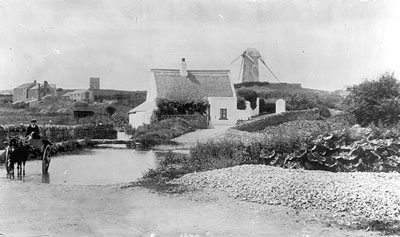
Much of north county Dublin, like Skerries, was rural in aspect. This photograph shows a mill cottage in Skerries c. 1910-30.
(NLI, EAS 1970)
This was a world of land stewards, like Sheridan of Loughshinny, Holmpatrick, farmers, like Coleman of Drumlattery, Holmpatrick , and farm labourers, like Masterson of Jordanstown, Holmpatrick. Across rural Dublin there were farmer-publicans (Walsh, Rathcoole village), grooms (Dawson of Brenanstown, Ballybrack), herdsmen (Brophy of Brenanstown, Ballybrack), poulterers (Moore of Newtown Ave., Blackrock), and meat merchants (Farley of Newtown Ave., Blackrock). Dublin was an important city, but it was also a country town

